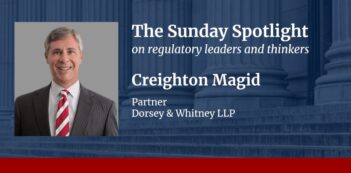
“Next Gen” thinking is fundamentally optimistic that we have the tools to improve regulatory compliance, if only we decide to use them.
When authors devote years to developing, researching, and writing about new ideas in a field to which they have devoted their careers, their most fervent hope is that their ideas get taken seriously by the long-admired leaders in that arena. Having some of those leading lights not only read but publicly engage with the ideas I put forth in my book, Next Generation Compliance: Environmental Regulation for the Modern Era, is therefore thrilling.
The review of my book by Cary Coglianese is like everything he writes: engaging, spot on, and deeply informed. He is the leading expert on regulatory design, evident throughout his own scholarship as a law professor at the University of Pennsylvania and his leadership as Director of the Penn Program on Regulation. He is one of a rare breed of academics who write for impact, and regularly get their own hands dirty taking on the messy problem of applying principles to real life. When I start reading an article written by Professor Coglianese, I know that I am going to learn something valuable. There is no more impressive or important voice on regulatory design, so his calling my book a “modern classic” is as good as it gets.
Jay Shimshack, a professor of public policy and economics at the Frank Batten School of Leadership and Public Policy at the University of Virginia, is another academic who not only writes about topics of immediate value and use to regulators, but who is also willing to share his deep expertise with people in government, including testifying before the U.S. House of Representatives—an exercise that is not for the faint of heart! Because of his practical orientation to scholarship, I deeply appreciate his praise for the book. I also agree with him that the ideas of Next Gen could greatly benefit from rigorous testing. Although there is strong evidence in the book’s case histories for types of approaches that strengthen compliance performance, I could not agree more that we do not know nearly enough about what works best. As Next Gen explains, there is no one-size-fits-all system for better compliance design; the right solution for one problem could be counterproductive in another. I hope that the book helps inspire that searching inquiry by opening our collective eyes to the reality that a change is needed. We are not getting the job done using the traditional approaches. But there are scores of other options available to remedy the problem. Once the demand for new solutions ratchets up, the research to provide answers can follow. As the book states: “Let’s decide to learn faster.”
All of the reviewers make the observation—with varying degrees of pointedness—that enforcement remains important. Absolutely. No matter how many times I say this, it bears repeating: Enforcement is essential. You cannot have an effective regulatory program without it. The examples raised by John Cruden, a friend and treasured colleague, underscore the truth of this reality.
For these reasons, I strongly second the concerns about underfunded civil and criminal enforcement voiced by progressive legend Rena Steinzor, a law professor at the University of Maryland Francis King Carey School of Law. Her misgivings on this score serve to reinforce my point. We should not leave communities’ health to the whims of changing political leadership at the state or federal levels. Victims of environmental injustice know from hard experience how unreliable it is to depend exclusively on enforcement to secure a healthy environment. Legislatures can be hostile to environmental protection and to environmental enforcement in particular, and that hostility is often reflected in both policy and funding. We cannot count on all political leadership to embrace holding polluters accountable. These are among the many compelling reasons to support designing rules with compliance built in, so that widespread compliance is the default and does not depend exclusively on enforcement being in political favor.
But even when enforcement is at its most robust, it cannot possibly be solely responsible for the herculean task of making badly designed rules deliver. If a rule provides pathways to obfuscate, avoid, or ignore, it will usually be impossible to right the ship through enforcement alone, no matter how well funded enforcement is. Regulators will always be overmatched in the resources arena, even at many times the resources they have today. But regulators have something that can tip the scales in favor of the public interest: strategies that motivate the regulated to do what’s required without the need for constant government vigilance. That is the guiding principle of Next Gen: How can we make sure the public interest prevails, despite the will-always-be-with-us pressures in the other direction?
Next Gen focuses on the practical: not the world as we wish it were, but the place where we actually live. It does not waste time on blame, but instead proposes solutions that might work, despite the many breakdowns in accountability, attention, resources and political will that characterize real life. Despite the dismal state of compliance for many rules today, Next Gen is fundamentally an optimistic idea. It says we have the tools to change the outcome. We just have to decide to use them.
This essay is not a product of the U.S. government or the U.S. Environmental Protection Agency (EPA). The author is not doing this work in any governmental capacity. The views expressed are her own and do not necessarily represent those of the United States or the EPA.
This essay is one of a six-part series on The Next Generation of Regulatory Compliance.




